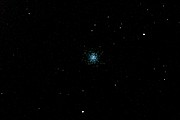
Purpose:
Testing new finder. Further testing of a
supertelephoto astrophotography rig
on soft deepsky targets.
Location:
Chula Vista Gliderport (alt. 500'). Conditions: clear, slight breezes.
Best results:
M13 Globular Cluster in Hercules at 27 seconds. Image cropped. 2003.04.30 21:45:32 800.0 mm 30 sec, f/5.7 Mode: Manual Metering: Center-weighted average ISO: 1250 AF mode: Manual Focus Drive: Continuous (high): frame 1 White balance: Auto Color matrix 1: sRGB natural-looking hue and chroma Flash: Off File size: 2,568KB Image size: 2464 x 1648 Sharpness level: Off Custom Functions: CFn 3: Extended ISO sensitivity
M4 Scorpius Globular with Antares. This object was just rising and barely visible through the skyglow, about 10 degrees off the horizon. The tracking held nicely. The globularity was difficult to ascertain at this angle. This object will be nice to try higher up in the sky. 2003.04.30 22:17:03 800.0 mm 30 sec, f/5.7 Mode: Manual Metering: Center-weighted average ISO: 1250 AF mode: Manual Focus Drive: Continuous (high): frame 1 White balance: Auto Color matrix 1: sRGB natural-looking hue and chroma Flash: Off File size: 2,587KB Image size: 2464 x 1648 Sharpness level: Off Custom Functions: CFn 3: Extended ISO sensitivity
M57 Ring Nebula in Lyra. Lyra was rising and this object was about 26 degrees off the horizon. It could not be directly seen in the Canon viewfinder. It is easy to locate though, as it is halfway between two bright stars in Lyra. Lining up the two stars is all that is required. As it turned out, even the hole showed up nicely. This is a 30 second exposure (27 seconds effective), and the ISO sensitivity was turned up to the highest setting, 3200. 2003.04.30 22:46:50 800.0 mm 30 sec, f/5.7 Mode: Manual Metering: Center-weighted average ISO: 3200 AF mode: Manual Focus Drive: Continuous (high): frame 1 White balance: Auto Color matrix 1: sRGB natural-looking hue and chroma Flash: Off File size: 3,385KB Image size: 2464 x 1648 Sharpness level: Off Custom Functions: CFn 3: Extended ISO sensitivity
4 Vesta in Virgo. Though bright for an asteroid, it is still not easy to locate visually, as it blends in well with the field stars. But it is fairly bright and can be tracked down by using a realtime astronomy program, such as Starry Night Pro. 1: 2003.04.30 23:05:40 800.0 mm 30 sec, f/5.7 Mode: Manual Metering: Center-weighted average ISO: 1250 AF mode: Manual Focus Drive: Continuous (high): frame 1 White balance: Auto Color matrix
Passing helicopter. This was an attempt to track a passing helicopter in the finder. 2003.04.30 21:40:08 800.0 mm 2.5 sec, f/5.7 Mode: Manual Metering: Center-weighted average ISO: 1250 AF mode: Manual Focus Drive: Continuous (high): frame 1 White balance: Auto Color matrix 1: sRGB natural-looking hue and chroma Flash: Off File size: 1,671KB Image size: 2464 x 1648 Sharpness level: Off Custom Functions: CFn 3: Extended ISO sensitivity
All exposures Canon EOS 1D, mounted on a Meade LXD300 eq mount. Image postprocessing included crop, resize and despeckle, and unsharp mask.
Conclusion:
The tracking ability of the Meade LX300 mount is subject to drift, due to
slippage. This appears to be an under-engineering of the RA clutch and lock.
The lock has to be tight, otherwise star trails will appear in low
magnification exposures of as short as 10 seconds.
The focus ability of the Canon EOS autofocus system appears inaccurate for astrophotography. Focus can be attempted on a star, and it will find and lock almost instantly. However, there is too much error, and better luck was obtained by actually focusing manually on the ground glass in the finder. A magnifying finder will have to be found or made.
Otherwise, some decent images, considering the low altitude and general sky-glow at the Gliderport location.
Images are copyright ©2002 Paul C. Martinez & Philip Brents. They may be used for any educational or scientific use - however, please reference or link to this page if you do so.